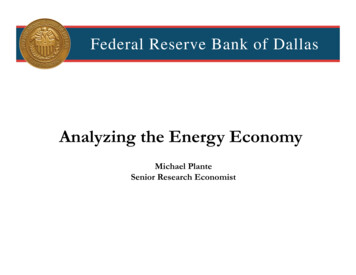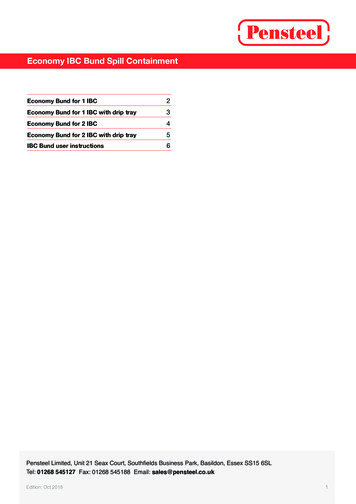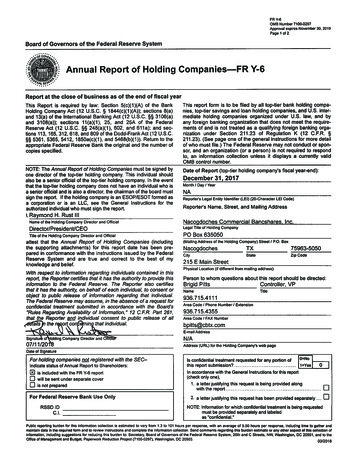
Transcription
Federal Reserve Bank of DallasAnalyzing the Energy EconomyMichael PlanteSenior Research Economist
DisclaimerDisclaimer: The statements in this presentation do notrepresent the official views of the Federal Reserve Bankof Dallas nor the Federal Reserve System as a whole.
Today’s talk is on the data What is the data series all about? Why are we interested in it? Who collects it and how? Where can you find it?
Oil prices over the last 30 yearsDollars per barrel (nominal)160West Texas Intermediate140crude oil spot TE: June 2016 data point is 49.02 per barrel, the average of price data for the weeks ending June 10 and June 17, 2016.SOURCE: Energy Information Administration.
Crude oils have different qualitiesSulfur content .01.5WTI(U.S.)1.0Brent(North ightAPI gravity (a measure of crude oil density)NOTES: WCS Western Canadian Select. WTI West Texas Intermediate. API American Petroleum Institute.SOURCES: Energy Information Administration; American Petroleum Institute.
Real prices low but not record lowDollars per barrel (May 2016 dollars)160West Texas Intermediate140crude oil spot price120100806040200198619911996200120062011NOTE: Data are adjusted for inflation using a core, urban, seasonally adjusted consumer price index (CPI).SOURCES: Bureau of Labor Statistics; Energy Information Administration.2016
Supply and Demand
World petroleum supply and demandMillion barrels per day989694929088Global supply86Global demand84200520072009NOTE: Dashed lines represents forecasts.SOURCE: International Energy Agency.2011201320152017
Supply has outpaced demandGrowth,million barrels per day3.0Annual worldproduction growthAverage annualworld consumptiongrowth2.52.01.51.00.50.02013SOURCE: International Energy Agency.201420152013–2015
Supply-demand balance improvingMillion barrels per NOTES: Shaded bars represent forecasts. Series is the difference between world petroleum supply and demand.SOURCE: International Energy Agency.
U.S. crude oil inventories highMillion barrels20152016Average levels 2010‐2014550500450400350300JanFebMarAprSOURCE: Energy Information Administration.MayJunJulAugSepOctNovDec
Consumer Data for the U.S.
Low oil prices low gas pricesDollars per gallon4.54.03.53.02.52.01.52011U.S. retail diesel priceU.S. retail gasoline price20122013NOTE: Series is the monthly average of weekly price data.SOURCE: Energy Information Administration.201420152016
U.S. consumers hit the road!Million gallons per OTE: April, May and June 2016 data points are averages of weekly estimates for those months.SOURCE: Energy Information Administration.OctNovDec
Production Data for the U.S.
Shale boosts U.S. oil productionMillion barrels per day1098765431990 1992 1994 1996 1998 2000 2002 2004 2006 2008 2010 2012 2014 2016NOTE: Last data point is 9.13 million barrels per day for March 2016.SOURCE: Energy Information Administration.
Handful of states take part in boomMillion barrels per tanaUtahColoradoWyomingNew MexicoOklahomaNorth Dakota1.111.100.240.0Jan '10 Mar '16SOURCE: Energy Information Administration.Jan '10 Mar '16Jan '10 Mar '16
Low prices deter new investmentRig count1,800U.S. oil rig 20062008NOTE: Last data point is 337 oil rigs for the week ending June 17, 2016.SOURCE: Baker Hughes.2010201220142016
Low prices deter new investmentRig count1,800U.S. oil rig 20062008NOTE: Last data point is 337 oil rigs for the week ending June 17, 2016.SOURCE: Baker Hughes.2010201220142016
Drilling rig at workSOURCE: Pixabay, photographer: Anita Starzycka.
Horizontal vs. vertical drillingSOURCE: Environmental Protection Agency.
Regional and Other Data
Energy in the 11 th 1/index.cfm)SOURCE: Federal Reserve Bank of Dallas.
Eagle Ford production dataBillion cubic feet per day6Million barrels per day1.81.651.4Shale oil production1.24Shale 22013201420152016NOTE: Data are through May 2016 and represent EIA’s official shale gas and tight oil estimates, but are not survey data.SOURCE: Energy Information Administration, based on data collected by DrillingInfo Inc.
Anecdotal and company info Beige Book x.cfm) Dallas Fed Energy h/surveys/des/index.cfm) Company reports (for publically traded companies)
Breakeven prices from the surveyNOTES: Line depicts the mean and bars depict the range of responses. Sixty‐three exploration and production firmsanswered this question in March 2016. Other U.S. includes Bakken, Kansas and Gulf of Mexico, among other responses.SOURCE: Federal Reserve Bank of Dallas, Dallas Fed Energy Survey.
Wrapping up We follow the oil and gas market regularly Data comes from a variety of sources (government,private sector, news sources, anecdotal) Hope to glean insights into the regional, national andglobal economies Questions?
Data sources
Data sources for pricesU.S. Energy Information mWall Street Journal and other papersBloomberg (http://www.bloomberg.com/energy)GasBuddy (http://www.gasbuddy.com/GasPriceMap)
Supply and demand dataInternational Energy Agency (Oil Market ic/U.S. Energy Information Administration(Short-Term Energy Outlook)http://www.eia.gov/forecasts/steo/
U.S. energy dataU.S. Energy Information Administration (oil, gas, electricity,renewables, etc.) http://www.eia.gov/Baker Hughes (rig count)http://phx.corporate-ir.net/phoenix.zhtml?c 79687&p irolrigcountsoverviewBureau of Labor and Statistics (employment data)http://www.bls.gov/
State and regional infoU.S. Energy Information Administration(http://www.eia.gov)EIA Drilling Productivity e government agenciesEnergy in the 11th District website
NOTE: June 2016 data point is 49.02 per barrel, the average of price data for the weeks ending June 10 and June 17, 2016. SOURCE: Energy Information Administration. 0 20 40 60 80 100 120 140 160 1986 1991 1996 2001 2006 2011 2016 West Texas Intermediate crude oil spot price Dollars per barrel (nominal)










